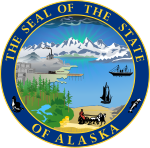| Elections in Alaska |
|---|
 |
The number of elections in Alaska (Iñupiaq: Alaaskam naliġagviat) varies by year, but typically municipal elections occur every year, plus primary and general elections for federal and state offices occur during even-numbered years. Alaska has a gubernatorial election every four years. Members of the state's United States congressional delegation run for election or re-election at the times set out in the United States Constitution. Primary elections assist in choosing political parties' nominees for various positions. On a regional basis (see list of boroughs and census areas in Alaska), elections also cover municipal issues. In addition, a special election can occur at any time.
In a 2020 study, Alaska was ranked as the 15th hardest state for citizens to vote in.[1]
In 2020, Alaskan voters approved an initiative to implement a nonpartisan blanket top-four primary with a single, open primary where candidates from all parties are listed on the ballot and the top four vote-getters advance to the general election.[2] This system went into effect with the 2022 elections. Prior to this, registered voters in Alaska were given a choice between three primary ballots reflecting a semi-closed primary system.[3] Specifically, Democratic, Libertarian, Alaskan Independence and Independent candidates were listed on one ballot available to all registered voters and Republican candidates were listed on a second ballot available to voters registered as Republican, Nonpartisan or Undeclared.[3] In 2024, Alaskans will vote on a measure to repeal the system and return to partisan primaries.[4]
- ^ J. Pomante II, Michael; Li, Quan (15 Dec 2020). "Cost of Voting in the American States: 2020". Election Law Journal: Rules, Politics, and Policy. 19 (4): 503–509. doi:10.1089/elj.2020.0666. S2CID 225139517. Retrieved 14 January 2022.
- ^ Piper, Kelsey (2020-11-19). "Alaska voters adopt ranked-choice voting in ballot initiative". Vox. Retrieved 2022-02-23.
- ^ a b Harrington, Susan (July 1, 2014). "Voter Registration: It's Not Automatic, but It's Easy". Alaska Business Monthly. Archived from the original on March 29, 2015.
Alaska law allows a political party to select who may participate in their party's primary.
- ^ Brooks, James (2024-08-23). "Alaska Supreme Court upholds ranked choice repeal initiative, now bound for November vote • Alaska Beacon". Alaska Beacon. Retrieved 2024-08-23.
